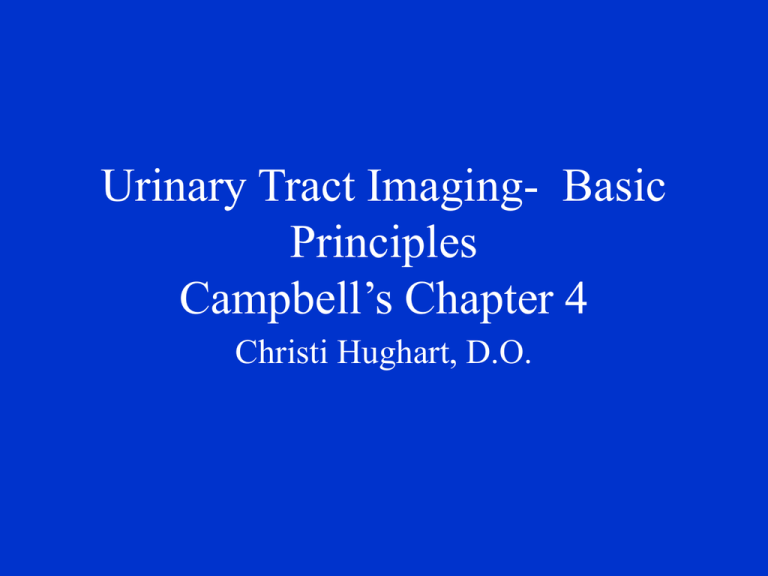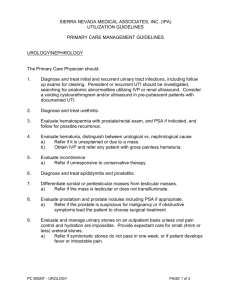Urinary Tract Imaging
advertisement

Urinary Tract Imaging- Basic Principles Campbell’s Chapter 4 Christi Hughart, D.O. Plain Films • Scout film, primary survey, to follow known stones, check placement of catheters/stents/drains/foreign bodies • False +: vascular calcifications, bowel opacities, phleboliths, appendicoliths, GS • False -: stone over sacrum/ilium, radiolucent (uric acid) • If scout before ESWL shows no stone, may need to reassess Plain FilmLeft Distal Ureteral Calculus • Contrast Films • Rapidly concentrated by kidneys and opacifies urinary tract • Low osmolar nonionic contrast material (LOCM)50% less osmolar load- fewer complications than high osmolar • Reactions: dose related or idiosyncratic – Allergic, CV changes, renal toxicity, shock – Tx- antihistamines, beta agonist, epinephrine – Renal toxicity risk (average patient)- 1% • Direct toxicity to renal tubules, ischemia, altered circulation, precipitation of uric acid • Prevention- well hydrated, LOCM, small load IV Urography • • • • • • • Renal parenchyma, collecting system, ureter Evaluates- urothelial abnormality, hematuria, urolithiasis +/- bowel prep/npo Scout, +/- obliques Contrast- bolus or drip Nephrographic phase- immediate to first minutes- parenchyma Pyelographic phase- 5 minutes- collecting system – +/- compression, oblique- calyces, prone to distend ureter, uprightrenal ptosis/layering in severe hydro, post-void- evaluate BOO/diverticulae/filling defect Normal Urogram • Urogram with Prone Filmbetter visualization of ureters • Loopography • Imaging of urinary conduit or diversion (always order with indication clearly explained) • Reflux required to see ureters if no IV contrast used (constrast sensitivity not contraindication) • If non-refluxing anastamosis- need IVU, antegrade nephrostomy, CT, MRI • Indications- hematuria, stones, stoma stenosis, loop ischemia, urinary fistulae, urine leak, stricture at anastamosis, hydro, tansitional cell cancer surveillance • Prep- bowel prep if previous contrast, antibiotics, GU irrigant • Contrast goes in thru catheter • Scout, supine, conduit distension, drainage film • Static Cystourethrography • Evaluate bladder lesion, rupture, leak, s/p trauma/sx- bladder integrity/anast/fistulas • Scout, fill bladder with 200-400 mL contrast via catheter, A/P and obliques (shows extravasation posterior to bladder), postdrainage film Voiding Cystourethrogram (VCUG) • Functional and anatomic evaluation of bladder • Typically for children with recurrent UTIs • Dx- reflux, urethral valves, ureterocele, dysfunctional voiding, urethral strictures, bladder/urethral diverticula • Scout • Pediatric: 5 or 8 F feeding tube, fill bladder with contrast (age +2 x 30) • Adult: standard catheter • Film during filling- bladder pathology, early reflux • Films during void- reflux, urethral abnormality • Oblique- evaluate grade 1 reflux, males • Post-void film Normal Male Cystogram • VCUG Retrograde Urethrogram (RUG) • Evaluate anterior and posterior urethrastrictures, trauma • 8-16 F foley in fossa navicularis, fill balloon with 1-2 mL and inject 30-50% contrast while filming obliquely • Some resistance at membranous urethra and sphincter Normal RUG • Retrograde Pyelography • Evaluate renal collecting system and ureters • Indications- hematuria, contrast sensitivity, suboptimal IVU, needs cysto • Pre-op- get sterile urine culture • IV sedation • Scout, injection catheter placed in UO, inject 50% contrast under real time fluoro, drainage film at 5-10 minutes • Backflow- contrast extravasation into surrounding tissues due to high injection pressure Normal RP • Nephrostogram • Antegrade urogram- inject contrast into nephrostomy tube • Indications- post-sx to evaluate for urine leak, post-perc neph to evaluate residual stones, evaluate site of ureter obstruction, dx ureteral fistulas • Prep- sterile urine sample, +/- antibiotics • • • Ultrasound Grayscale and doppler High frequency- high resolution but low penetration depth Renal- parenchyma, solid vs cystic, hydro – Use with IVP to evaluate hematuria – Assess allografts, congenital abnormalities, stones – Cortex vs medulla- pyramids (medulla) less echogenic than cortex • Adrenal- CT/MRI better except in peds (no RP fat) – Nodules, cysts, hemorrhage, location, tumors – Cortex hypoechoic, medulla echogenic • Bladder- examine wall, lesions – – – – – • Transvaginal, transabdominal, transrectal Normal wall >= 6 mm Echogenicity in bladder fluid- debri, FB, infection PVR, bladder volume Ureteral jets- should appear in 15 minutes unless obstruction exists Prostate- transrectal, access for biopsy Ultrasound (cont.) • Scrotal– Use high frequency probe (up to 10 MHz) – Evaluate- mass, pain, torsion, orchitis, epididymitis, hydrocele, hernia, varicoceles – Testicle- granular, 4 x 3 cm, small anterior fluid collectiontunica, epididymis- hyperechoic – Veins- >2mm= varicocele- evaluate in erect position with valsalva • Urethral– Male- evaluate stricture- scar length and depth, longitudinal along phallus or intraluminal – Female- diverticulum • • • • • • • • CT • • • • Contrast- parenchyma, adrenals 3-D or CTA- evaluate vascular abnormality 100-150 mL IV bolus injection Renal– Precontrast- stones, parenchyma, vascular calcifications, renal contour – Corticomedullary- 30 sec- cortex vs medulla – Nephrographic- 100 sec- uniform enhancement of parencyma (masses) – Pyelographic- excretory- collecting system – Left renal vein- anterior to aorta, inf/post to SMA – Right renal vein- extends posterolateral from IVC CT (cont.) • • Adrenal– Malignancy, mets, functional adenoma – Adenoma- HU <0 – HU >20- ? Mets- do perc bx – MRI if suspect pheo Bladder– Depends on amount of distension • Prostate/seminal vesicle– To detect abscess or cyst – If prominent median lobe- appears to extend into bladder • CT urography– Enhanced CT of ureters CTA • Rapid contrast injection with helical CT during arterial phase • Soft tissue and bone reduced • 3D reconstruction • Indications- prep for donor nephrectomy, eval extra vessels to eval UPJ obstruction, renal artery stenosis • MRI • No iodinated contrast • Soft tissue resolution better than CT • Contraindications- pacer, aneurysm clips, FB, prosthesis • Allignment of protons in response to external magnet- radiofrequency applied causes difference in their energy • T1- fluid dark, fat bright • T2- fluid bright, fat dark MRI (cont.) • Renal- do if need cross-sectional images but contrast contraindicated, will not evaluate stones, determine tumor thrombus in IVC, cortex bright on T1 • Adrenal- adenomas contain more fat than cancers/pheos, pheo bright on T2, gland seen easily on T1, T2- adrenals isodense with liver • Bladder- to id invasion of wall by transitional cell cancer or other pelvic neoplasms (on T2) • Prostate- evaluate prostate cancer for capsular invasion. T1-distinct from surrounding fat/seminal vesicles (intermediate intensity), T2peripheral zone (high intensity), central (intermediate), neurovascular bundles bright, seminal vesicles (high) • Urethral- intraluminal coil to evaluate stricture/diverticulum • MRU- to id obstruction- ureters/collecting system- T2- fluid bright, tissue dark (can’t distinguish stone from clot/tumor) MRA • Gadolinium • Indications- abdominal aorta, ranal artery stenosis, pre-donor nephrectomy Nuclear Scintigraphy • Physiologic and anatomic info • TC-99 m (t ½= 6 hrs) • MAG3- cleared by tubular secretion, no glomerular infiltration- evaluate renal function and renal plasma flow • DTPA- glomerular filtration- evaluate obstruction and renal function • DMSA- cleared by filtration and secretion- renal cortical image Diuretic Scintigraphy • For hydro not necessarily caused by obstruction • Done with DTPA or MAG3 (better for renal insufficiency) • When tracer reaches collecting system, diuretic given and t ½ calculated based on slope of curve given in response to diuretic Renal Cortical Scintigraphy • DMSA to evaluate for cortical scars or pyelo • Do 3 months after infection








